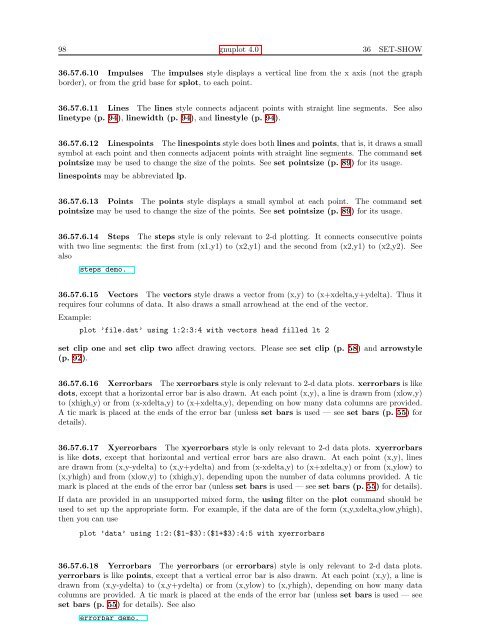GNUPlot Manual
GNUPlot Manual
GNUPlot Manual
You also want an ePaper? Increase the reach of your titles
YUMPU automatically turns print PDFs into web optimized ePapers that Google loves.
98 gnuplot 4.0 36 SET-SHOW<br />
36.57.6.10 Impulses The impulses style displays a vertical line from the x axis (not the graph<br />
border), or from the grid base for splot, to each point.<br />
36.57.6.11 Lines The lines style connects adjacent points with straight line segments. See also<br />
linetype (p. 94), linewidth (p. 94), and linestyle (p. 94).<br />
36.57.6.12 Linespoints The linespoints style does both lines and points, that is, it draws a small<br />
symbol at each point and then connects adjacent points with straight line segments. The command set<br />
pointsize may be used to change the size of the points. See set pointsize (p. 89) for its usage.<br />
linespoints may be abbreviated lp.<br />
36.57.6.13 Points The points style displays a small symbol at each point. The command set<br />
pointsize may be used to change the size of the points. See set pointsize (p. 89) for its usage.<br />
36.57.6.14 Steps The steps style is only relevant to 2-d plotting. It connects consecutive points<br />
with two line segments: the first from (x1,y1) to (x2,y1) and the second from (x2,y1) to (x2,y2). See<br />
also<br />
steps demo.<br />
36.57.6.15 Vectors The vectors style draws a vector from (x,y) to (x+xdelta,y+ydelta). Thus it<br />
requires four columns of data. It also draws a small arrowhead at the end of the vector.<br />
Example:<br />
plot ’file.dat’ using 1:2:3:4 with vectors head filled lt 2<br />
set clip one and set clip two affect drawing vectors. Please see set clip (p. 58) and arrowstyle<br />
(p. 92).<br />
36.57.6.16 Xerrorbars The xerrorbars style is only relevant to 2-d data plots. xerrorbars is like<br />
dots, except that a horizontal error bar is also drawn. At each point (x,y), a line is drawn from (xlow,y)<br />
to (xhigh,y) or from (x-xdelta,y) to (x+xdelta,y), depending on how many data columns are provided.<br />
A tic mark is placed at the ends of the error bar (unless set bars is used — see set bars (p. 55) for<br />
details).<br />
36.57.6.17 Xyerrorbars The xyerrorbars style is only relevant to 2-d data plots. xyerrorbars<br />
is like dots, except that horizontal and vertical error bars are also drawn. At each point (x,y), lines<br />
are drawn from (x,y-ydelta) to (x,y+ydelta) and from (x-xdelta,y) to (x+xdelta,y) or from (x,ylow) to<br />
(x,yhigh) and from (xlow,y) to (xhigh,y), depending upon the number of data columns provided. A tic<br />
mark is placed at the ends of the error bar (unless set bars is used — see set bars (p. 55) for details).<br />
If data are provided in an unsupported mixed form, the using filter on the plot command should be<br />
used to set up the appropriate form. For example, if the data are of the form (x,y,xdelta,ylow,yhigh),<br />
then you can use<br />
plot ’data’ using 1:2:($1-$3):($1+$3):4:5 with xyerrorbars<br />
36.57.6.18 Yerrorbars The yerrorbars (or errorbars) style is only relevant to 2-d data plots.<br />
yerrorbars is like points, except that a vertical error bar is also drawn. At each point (x,y), a line is<br />
drawn from (x,y-ydelta) to (x,y+ydelta) or from (x,ylow) to (x,yhigh), depending on how many data<br />
columns are provided. A tic mark is placed at the ends of the error bar (unless set bars is used — see<br />
set bars (p. 55) for details). See also<br />
errorbar demo.

















